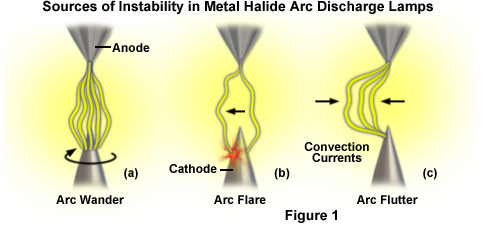Illumination sources based on plasma discharge (arc lamps) require a considerable period after ignition to reach thermal equilibrium, a factor that can affect temporal, spatial, and spectral stability. All lamps that produce a significant level of heat, including arc discharge lamps, also exhibit a dependence of emission output on the source temperature. In many cases, a period of up to one hour is required until the illumination source is sufficiently stable to enable reproducible measurements or to record time-lapse video sequences without significant temporal variations in intensity. Generally, arc discharge lamps are the most unstable illumination sources currently used in optical microscopy. Besides the fact that the arc exhibits a significant degree of chaotic, flickering discharge that worsens with age, the light output can also be affected by ambient electromagnetic fields or an unstable power supply.

The interactive tutorial initializes with two windows showing an ideal arc traveling between the cathode and anode of a virtual arc discharge lamp. To operate the tutorial, use the Cathode Tip Age slider to transition between a new and old lamp. As the slider is tranlated to the right, the phenomenon of arc wander can be observed in the right-hand window, followed by flare and flutter, which are discussed in greater detail below.

In general, arc lamps exhibit significantly less stability than do filament lamps because the gas plasma is inherently unstable and can be affected both by magnetic fields and erosion of the electrode tips. The larger radius of curvature that slowly occurs as the electrodes degenerate results in a reduction of current flow (and brightness) near the cathode tip and also increases the power level required to sustain the arc. Short term stability is compromised by three recurring artifacts of the arc-discharge created between the tungsten electrodes: (1) Arc wander occurs when the attachment point of the arc on the conical cathode tip traverses the electrode in a circular pattern (see Figure 1(a)), usually requiring several seconds to complete the full circle. (2) Flare refers to the momentary change in brightness as the arc relocates to a new area on the cathode with a higher emissive quality than the previous attachment point (Figure 1(b)). (3) Convection currents in the xenon gas or mercury vapor that arise from a temperature differential between the arc and the envelope generate arc flutter, which is manifested by rapid lateral displacement of the arc column (Figure 1(c)). Eventually, the electrodes deteriorate to the point that the lamp will no longer ignite.
Contributing Authors
Tony B. Gines and Michael W. Davidson - National High Magnetic Field Laboratory, 1800 East Paul Dirac Dr., The Florida State University, Tallahassee, Florida, 32310.




